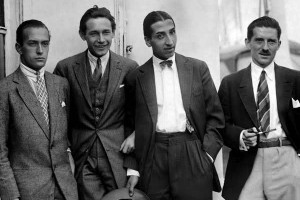“Whenever Paris comes to mind, their images loom,” wrote 1931 Wimbledon champion Sidney Wood in his book THE WIMBLEDON FINAL THAT NEVER WAS of the famous Four Musketeers – Rene Lacoste, Henri Cochet, Jean Borotra and Jacques Brugnon. Roland Garros, the site of the French Open, was built as sort of tennis version of the Arc de Triomphe, as the four Frenchmen wrestled the Davis Cup from the hands of Bill Tilden and the United States in 1927. In need of a site to host the matches the following year, the French constructed Roland Garros, which also became the home to their annual French Championships, the modern day French Open – or Roland Garros if you will.
Wood was a contemporary of the Four Musketeers and in THE WIMBLEDON FINAL THAT NEVER WAS ($15.95, New Chapter Media, available here in hard copy or on Kindle: http://www.amazon.com/The-Wimbledon-Final-That-Never/dp/0942257847/ref=sr_1_1?ie=UTF8&qid=1338836272&sr=8-1 he devotes a chapter to Cochet, which is excerpted below. Cochet, in fact, has won more titles at the French Championships than anyone – nine in all, including four in singles, three in doubles and two in mixed. Only Rafael Nadal and Bjorn Borg have won more men’s singles titles (six each).
The excerpt from the chapter called “The French Connection” is found below.
***

Henri Cochet, a steel sinewed rarity out of Lyon, France, was the only true magician the game has known. With a serve your grandmother wouldn’t trade for, Henri would step up to mid court, and handling his racquet like a toothpick, half-volley your returns.
The most imaginatively memorable shot I have ever borne witness to was at a France vs. U.S. Davis Cup doubles match in Paris. Cochet made a move to poach on an anticipated John Van Ryn crosscourt forehand return of a serve by Cochet’s partner Jacques Brugnon. Rather then belting his assured cross-court forehand return, Van Ryn instead belted the ball down the alley. Henri pirouetted 180 degrees clockwise and with back to the net and blind to the ball, made contact for a crazy winner. He was so damned creative he made us all feel we were in chains. Big Bill Tilden, John McEnroe, Frank Sedgman and perhaps Yannick Noah are the only other players I can think of to remind me of a few, but very few, of Henri’s electrifying improvisations.
Henri’s reasonably hard first serve landed in the box perhaps half the time, but neither first nor second could break a canary egg. However, he was deceptively clever enough to keep those run-around forehanders from cramming the ball down his or his partner’s throat. Henri’s primary objective: to make his way to the net, where his one-in-a-million powers of anticipation made him ten feet tall!
First-time opponents who might assume, as I once did, that Henri could be a profitable lobbing target, were quickly disabused. He had an uncanny ability to get comfortably under every ball, however deep, and sweet-spot hammer the ball for sharply-angled winners. Let me offer a provocative tidbit how this four-time No. 1 would have fared against such mid-moderns as Pancho Gonzales. It was about five years after Cochet’s retirement that Donald Budge rocketed onto the tennis scene. Knowing that from age 15 I had seen most of Henri’s big-time matches, as well as twice playing him, Don once asked me if Gonzales wouldn’t have made mincemeat of his second serve. You can say I gave Don pause by noting that Frank Shields could garner but a single set of the eleven he played against Henri in major events. It happened that Don’s question was posed only minutes after he had barely survived a 6-4 fifth set of a Newport match against inspired but over-the-hill Frank, and Don’s legs were aching from crouching down to receive Frank’s blockbuster serves.
Cochet spoke barely a word of English when he came to America and captured the U.S. Nationals in 1928, accompanied by a wife, mother-in-law and a mixed doubles partner. My sputtering French persuaded him to invite me to serve as both his interpreter and practice mate. I had played him fairly close at Roland Garros that May (Henri tended to get a bit careless at times), and though I was only 16 at the time and a bit startled by the menage a trois, it sure didn’t deter me from accepting Henri’s hugely flattering invite. France’s famous Four Musketeers of tennis, as Henri Cochet, René Lacoste, Jean Borotra, and Jacques “Toto” Brugnon were known, were ever supportive teammates throughout their decades of widely disparate careers. I frequently ran into Jean, a much-traveled businessman, but René and Henri were somewhat closer pals of mine, and whenever Paris comes to mind, their images loom.
